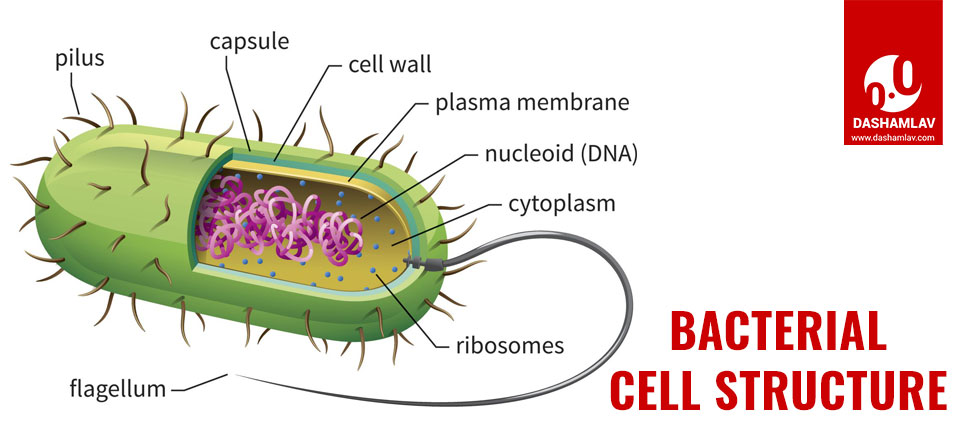Bacteria are single-cell, prokaryotic microorganisms. These microorganisms are found everywhere on Earth. They are present in soil, water, ice, oceans, on the bodies of other organisms and inside them too. Some bacteria live in symbiotic and parasitic relationship with other organisms too. Although most bacteria are harmless (and some bacteria are even useful too!) to human beings, some bacteria can cause diseases. In this article we are discussing some of the major diseases caused by bacteria in human beings.
ALSO SEE: Diseases caused by viruses
1. Tuberculosis (TB)
Disease-causing bacteria: Mycobacterium tuberculosis
Symptoms: Chronic cough with blood-containing mucus, fever, night sweats, and weight loss.
Mode of Transmission: TB spreads from one person to another through the air when people who have active TB in their lungs cough, spit, speak, or sneeze.
Tuberculosis has been present in humans since ancient times. It was also known as Consumption due to the observation that TB consumes the body weight. Today, TB is one of the most widespread disease among humans. As per some estimates, in 2018 25% of the world’s population has latent infection with TB. In 2018, 10 million cases of active TB occurred which resulted in 1.5 million deaths.
2. Tetanus
Disease-causing bacteria: Clostridium tetani
Symptoms: Spasms that begin in the jaw and then progress to the rest of the body. Other symptoms of tetanus may include fever, sweating, headache, trouble swallowing, high blood pressure, and a fast heart rate.
Mode of Transmission: Infection occurs through cut or puncture wound in skin by a contaminated object. Tetanus does not spread between people.
Clostridium tetani is a rod-shaped, Gram-positive bacterium. Tetanus is also known as lockjaw. It occurs in all parts of the world but is most frequent in hot and wet climates. Cause of tetanus was determined by Antonio Carle and Giorgio Rattone in 1884. A vaccine for tetanus was developed in 1924. Nevertheless, in 2015 there were about 209,000 tetanus infections and about 59,000 deaths globally.
3. Typhoid
Disease-causing bacteria: Salmonella enterica subsp. enterica serovar Typhi
Symptoms: Onset of a high fever over several days, weakness, abdominal pain, constipation, headaches, and mild vomiting.
Mode of Transmission: Typhoid spreads through food or water contaminated with feces.
In 2015, 12.5 million new cases of typhoid fever were reported worldwide. Of these about 149,000 people had died. Although typhus is a different disease but the name of typhoid has been derived from typhus. Typhoid means typhus-like.

4. Diphtheria
Disease-causing bacteria: Corynebacterium diphtheriae
Symptoms: Sore throat, fever, a grey or white patch in the throat.
Mode of Transmission: Diphtheria spreads between people by direct contact or through the air. It may also be spread by contaminated objects.
In 2015, 4,500 cases were officially reported worldwide. Diphtheria was first described in the 5th century BC by Hippocrates. The causing bacteria was identified by Edwin Klebs in 1882.
5. Leprosy
Disease-causing bacteria: Mycobacterium leprae or Mycobacterium lepromatosis
Symptoms: Runny nose; dry scalp; eye problems; skin lesions; muscle weakness; reddish skin; smooth, shiny, diffuse thickening of facial skin, ear, and hand; loss of sensation in fingers and toes; thickening of peripheral nerves; a flat nose due to destruction of nasal cartilage.
Mode of Transmission: Transmission of leprosy is not well understood, but it is thought to spread between people, although extensive contact is necessary.
Leprosy has affected humanity for thousands of years and historically been associated with social stigma. Leprosy is curable with multidrug therapy. A combination of dapsone, rifampicin, and clofazimine is often used over several months to treat Leprosy. In 2016, the number of new Leprosy cases was 216,000. Most the new cases occurred in 14 countries, with India accounting for more than half.
6. Syphilis
Disease-causing bacteria: Treponema pallidum subspecies pallidum
Symptoms: It was referred to as “the great imitator” by Sir William Osler due to its varied presentations. In primary stage, skin ulcerations occur in the cervix, penis or anus.
Mode of Transmission: Syphilis is most commonly spread through sexual activity. It may also be transmitted from mother to baby during pregnancy or at birth.
In 2015, about 45.4 million people were infected with syphilis, with six million new cases. In the same year, syphilis caused 107,000 deaths worldwide. The risk of sexual transmission of syphilis can be reduced by using a latex or polyurethane condom. Syphilis can be effectively treated with antibiotics.
7. Cholera
Disease-causing bacteria: Vibrio cholerae
Symptoms: Watery diarrhea, vomiting, muscle cramps, sunken eyes, cold skin, decreased skin elasticity, and wrinkling of the hands and feet.
Mode of Transmission: Transmission is usually through the fecal-oral route of contaminated food or water.
Cholera has been classified as a pandemic and an estimated 3–5 million people get infected worldwide. It causes 28,800–130,000 deaths a year. Risk factors for cholera include poor sanitation, not enough clean drinking water, and poverty.
8. Gonorrhea
Disease-causing bacteria: Neisseria gonorrhoeae
Symptoms: Infected men feel pain or burning with urination, discharge from the penis, or testicular pain. Infected women may experience burning with urination, vaginal discharge, vaginal bleeding between periods, or pelvic pain.
Mode of Transmission: Gonorrhea spreads through sexual contact (oral, anal, and vaginal sex) with an infected person. This disease can also spread from a mother to a child during birth.
Gonorrhea, also known as the clap, is a sexually transmitted infection. It affects about 0.8% of women and 0.6% of men worldwide. In 2015, it caused about 700 deaths. Gonorrhea can be treated usually with ceftriaxone by injection and azithromycin by mouth.
Use the citation below to add this article to your bibliography
"Diseases Caused by Bacteria: Symptoms and Mode of Transmission." Dashamlav.com. Web. 12 June 2025. <https://dashamlav.com/diseases-caused-by-bacteria-symptoms-transmission/>
Dashamlav.com, "Diseases Caused by Bacteria: Symptoms and Mode of Transmission." Accessed 12 June 2025. https://dashamlav.com/diseases-caused-by-bacteria-symptoms-transmission/
"Diseases Caused by Bacteria: Symptoms and Mode of Transmission." (n.d.). Dashamlav.com. Retrieved 12 June 2025 from https://dashamlav.com/diseases-caused-by-bacteria-symptoms-transmission/
